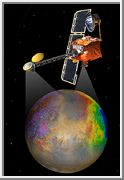|
COMETS EARTH JUPITER KUIPER BELT MARS MERCURY METEORITES NEPTUNE OORT CLOUD PLUTO SATURN SOLAR SYSTEM SPACE SUN URANUS VENUS ORDER PRINTS
PHOTO CATEGORIES SCIENCEVIEWS AMERICAN INDIAN AMPHIBIANS BIRDS BUGS FINE ART FOSSILS THE ISLANDS HISTORICAL PHOTOS MAMMALS OTHER PARKS PLANTS RELIGIOUS REPTILES SCIENCEVIEWS PRINTS
|
Related Document
Download Options
NASA's 2001 Mars Odyssey mission will map the amount and distribution of chemical elements and minerals that make up the Martian surface and will also study the planet's landforms. The Odyssey orbiter will look for hydrogen, most likely in the form of water ice, in the shallow subsurface of Mars. It will also characterize the radiation environment at Mars to determine health risks for any future human explorers. Scheduled for launch in April 2001, the spacecraft will arrive at Mars in October 2001. It will gradually use the friction of the atmosphere to lower its orbit (a technique called aerobraking) before beginning a full Martian year (2 Earth years) of science operations. Odyssey will also serve as a communications relay for U.S. and international landers arriving at Mars in 2003/2004. |
